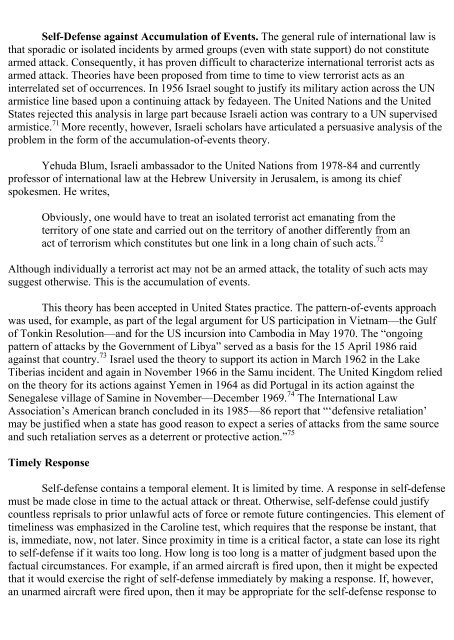Legitimate use of military force against state-sponsored - Air University
Legitimate use of military force against state-sponsored - Air University
Legitimate use of military force against state-sponsored - Air University
Create successful ePaper yourself
Turn your PDF publications into a flip-book with our unique Google optimized e-Paper software.
Self-Defense <strong>against</strong> Accumulation <strong>of</strong> Events. The general rule <strong>of</strong> international law is<br />
that sporadic or isolated incidents by armed groups (even with <strong>state</strong> support) do not constitute<br />
armed attack. Consequently, it has proven difficult to characterize international terrorist acts as<br />
armed attack. Theories have been proposed from time to time to view terrorist acts as an<br />
interrelated set <strong>of</strong> occurrences. In 1956 Israel sought to justify its <strong>military</strong> action across the UN<br />
armistice line based upon a continuing attack by fedayeen. The United Nations and the United<br />
States rejected this analysis in large part beca<strong>use</strong> Israeli action was contrary to a UN supervised<br />
armistice. 71 More recently, however, Israeli scholars have articulated a persuasive analysis <strong>of</strong> the<br />
problem in the form <strong>of</strong> the accumulation-<strong>of</strong>-events theory.<br />
Yehuda Blum, Israeli ambassador to the United Nations from 1978-84 and currently<br />
pr<strong>of</strong>essor <strong>of</strong> international law at the Hebrew <strong>University</strong> in Jerusalem, is among its chief<br />
spokesmen. He writes,<br />
Obviously, one would have to treat an isolated terrorist act emanating from the<br />
territory <strong>of</strong> one <strong>state</strong> and carried out on the territory <strong>of</strong> another differently from an<br />
act <strong>of</strong> terrorism which constitutes but one link in a long chain <strong>of</strong> such acts. 72<br />
Although individually a terrorist act may not be an armed attack, the totality <strong>of</strong> such acts may<br />
suggest otherwise. This is the accumulation <strong>of</strong> events.<br />
This theory has been accepted in United States practice. The pattern-<strong>of</strong>-events approach<br />
was <strong>use</strong>d, for example, as part <strong>of</strong> the legal argument for US participation in Vietnam—the Gulf<br />
<strong>of</strong> Tonkin Resolution—and for the US incursion into Cambodia in May 1970. The “ongoing<br />
pattern <strong>of</strong> attacks by the Government <strong>of</strong> Libya” served as a basis for the 15 April 1986 raid<br />
<strong>against</strong> that country. 73 Israel <strong>use</strong>d the theory to support its action in March 1962 in the Lake<br />
Tiberias incident and again in November 1966 in the Samu incident. The United Kingdom relied<br />
on the theory for its actions <strong>against</strong> Yemen in 1964 as did Portugal in its action <strong>against</strong> the<br />
Senegalese village <strong>of</strong> Samine in November—December 1969. 74 The International Law<br />
Association’s American branch concluded in its 1985—86 report that “‘defensive retaliation’<br />
may be justified when a <strong>state</strong> has good reason to expect a series <strong>of</strong> attacks from the same source<br />
and such retaliation serves as a deterrent or protective action.” 75<br />
Timely Response<br />
Self-defense contains a temporal element. It is limited by time. A response in self-defense<br />
must be made close in time to the actual attack or threat. Otherwise, self-defense could justify<br />
countless reprisals to prior unlawful acts <strong>of</strong> <strong>force</strong> or remote future contingencies. This element <strong>of</strong><br />
timeliness was emphasized in the Caroline test, which requires that the response be instant, that<br />
is, immediate, now, not later. Since proximity in time is a critical factor, a <strong>state</strong> can lose its right<br />
to self-defense if it waits too long. How long is too long is a matter <strong>of</strong> judgment based upon the<br />
factual circumstances. For example, if an armed aircraft is fired upon, then it might be expected<br />
that it would exercise the right <strong>of</strong> self-defense immediately by making a response. If, however,<br />
an unarmed aircraft were fired upon, then it may be appropriate for the self-defense response to
















